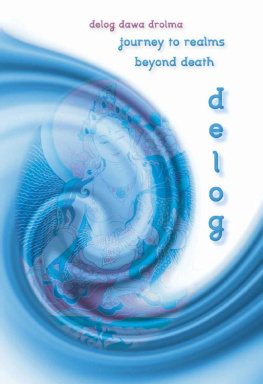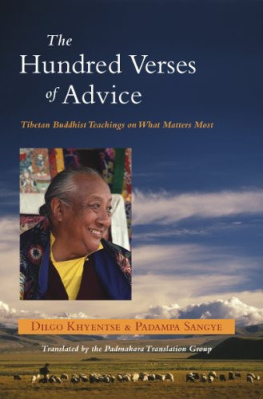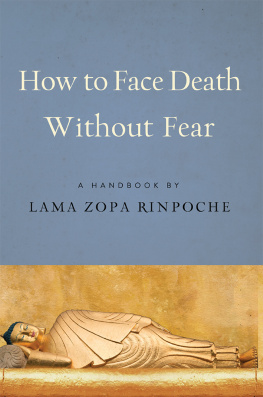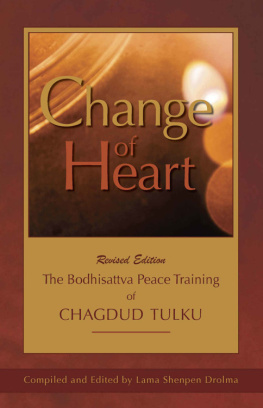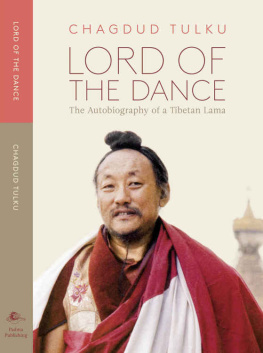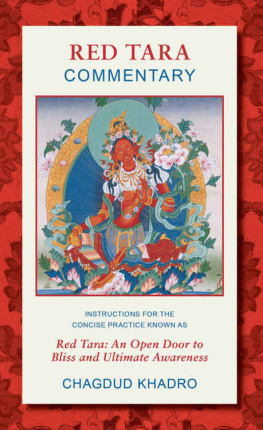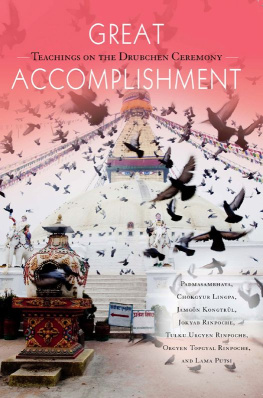Published by Padma Publishing
P.O. Box 279, Junction City, CA 96048-0279
www.tibetantreasures.com
Padma Publishing 1987
Second edition 2000; Reprinted 2006; eBook 2015
Printed in the United States of America
All rights reserved. No part of this book may be reproduced in any form or by any means, electronic or mechanical, including photocopy, recording or any information storage or retrieval system, without permission in writing from the publisher.
Library of Congress catalog card number: 99-044722
ISBN: 978-1-881847-11-3 (Softcover, 94 pages)
ISBN: 978-1-881847-50-2 (eBook)
Contents
Preface to the First Edition
THIS BOOK IS BASED ON A LECTURE given in Salem, Oregon, under the sponsorship of the Growth Place. Those who attended that lecture came from a variety of spiritual and intellectual disciplines to explore the topic of death from a Tibetan Buddhist perspective.
Every religion has its own teachings on the nature of death and its own methods for dealing with the death transition. My teachings come from an unbroken lineage of Buddhist meditation masters that extends back more than 2,500 years to Shakyamuni Buddha. The teachings of these masters have enduring relevance, because they are based on actual meditative insights into the passage of death and because they consistently relate death to life.
Buddhist masters see death not as an isolated event but as one more change in a never-ending cycle of changes. Those who hear Tibetan Buddhist teachings on death have the fortunate opportunity to learn to use their minds power to direct these changes and to gain control over their livesand over death. Death is a potent reminder to use life well.
The original lecture transcript has been reworked to clarify and expand certain points. A number of my students have helped in the preparation of this book, but special acknowledgment goes to Tsering Everest, who translated the original lecture.
Just as I hope that those at the lecture took home something of value that they could integrate into their own disciplines, so it is my heartfelt wish that you, likewise, will find this book useful in thinking about your life and preparing for your death. Beyond this, it is my wish that any positive influence these teachings may have on your mind expand outwardly as pure waves of compassion toward all others.
Chagdud Tulku Rinpoche
Cottage Grove, Oregon
Spring 1987
Introduction
DEATH AND DYING IS A SUBJECT that evokes such deep and disturbing emotions that we usually try to live in denial of death. Yet we could die tomorrow, completely unprepared and helpless. The time of death is uncertain but the truth of death is not. All who are born will certainly die.
People often make the mistake of being frivolous about death and think, Oh, well, death happens to everybody. Its not a big deal, its natural. Ill be fine.
This is a nice theory until one is dying. Then experience and theory differ. Then one is powerless and everything familiar is lost. One is overwhelmed by a great turbulence of fear, disorientation, and confusion. For this reason it is essential to prepare well in advance for the moment when the mind and body separate.
There are many methods, extraordinary and ordinary, to prepare for the transformation of death. The greatest of these results in enlightenment in ones lifetime. In enlightenment, death has no relevance to ones state of being. Enlightened realization is deathless, but it requires flawless meditative practice.
If deathless enlightenment is not accomplished during ones lifetime, the transition of death itself offers another supreme opportunity to attain enlightenment. But again, realizing the potential of this opportunity depends on having mastered certain meditative skills.
Enlightenment is the highest attainment of the death transition, but it is not the only one. If meditative realization is incomplete yet one has developed the power of prayer, there can be liberation into an environment of perfect bliss, free of suffering, by invoking the blessings of enlightened wisdom beings.
To accomplish the meditative skills and power needed to direct our mind at death, we must learn about the relationship of life and death, about the process of dying, and about the transitions from the moment of death until rebirth. In this way we become familiar with death and are not caught by surprise as the process begins to unfold.
Warned of a hurricane, we dont wait until the storm pounds the shore before we start to prepare. Similarly, knowing death is looming offshore, we shouldnt wait until it overpowers us before developing the meditative skills necessary to achieve the great potential of the mind at the moment of death.
DEATH AS WELL AS BIRTH, sickness, and old age are the four basic afflictions of the human condition. They are obvious and inescapable, in our personal experience and the experiences of other people. Yet these four afflictions fall within the larger categories of suffering that are experienced by all beings, human and nonhuman alike.
One of the greatest sufferings of sentient beings is the pain they experience from not getting what they want or getting what they think they want, then finding it is not enough or that it is not what they really want. These constant frustrations are intrinsic to the impermanent, changeable nature of cyclic existence.
Then there is suffering atop suffering, which means that no matter how bad it is, it can get worse. On the day you lose your wallet, your tooth begins to ache and you get a furious call from your boss. Or on a larger scale, countries plagued by famine are also wracked by war.
Suffering pervades cyclic existence like oil pervades sesame seeds. Like the oil, the complete pervasiveness of suffering is not always apparent, especially in phases when pleasure predominates and things seem to go well. Yet, just as oil becomes obvious when the hard little seeds are ground and pressed, so latent suffering is directly experienced when our layers of egotistic assumptions crack under the oppression of cyclic existence.
Why is it like this? The answer is that we are subject to karma, the inexorable law of cause and effect. The question that follows logically is: What causes karma? The root cause is the poisons of the mind. Our mind is basically confused, because we do not recognize its absolute nature. Lacking this understanding, we slip into an erroneous framework, which is duality.
We first grasp at a self who perceives and an object that is perceived. Seeing the object, we define its size, shape, and color. Then we judge it: Its pretty. Its ugly. I like it. I dont like it. It makes me happy. It makes me unhappy. Finally, we feel either attachment or aversion: I want it. I dont want it. This is where suffering begins.
The Twofold Truth: Relative and Absolute
OUR PERCEPTIONS OF SELF AND OBJECT, and our vacillation between attachment and aversion, are dualistic processes that occur in the mind. They are from the very outset a fictitious mode of perception. Once this dualistic process comes into play, we swing from one confusion to another, endlessly. And so we suffer, endlessly.
All suffering really comes from not knowing our true nature and from attachment and aversion, which are byproducts of our ignorance. Because of these poisons we further complicate the spiral of suffering by non-virtuous actions, speech, and thoughts. This dualistic mentality produces relative truth. In order to understand this term, consider the example of going to bed at night. There you are, between your warm sheets. Everything is safe. There is no problem. But through your mind, you leave your waking experience and begin your dream experience.



